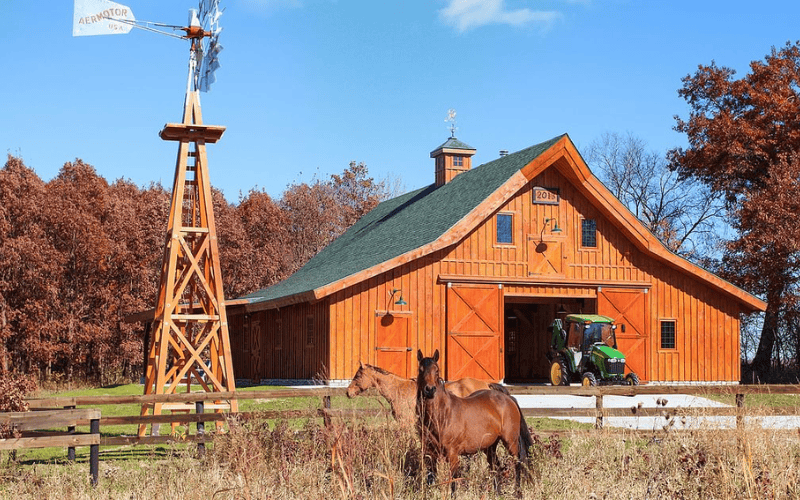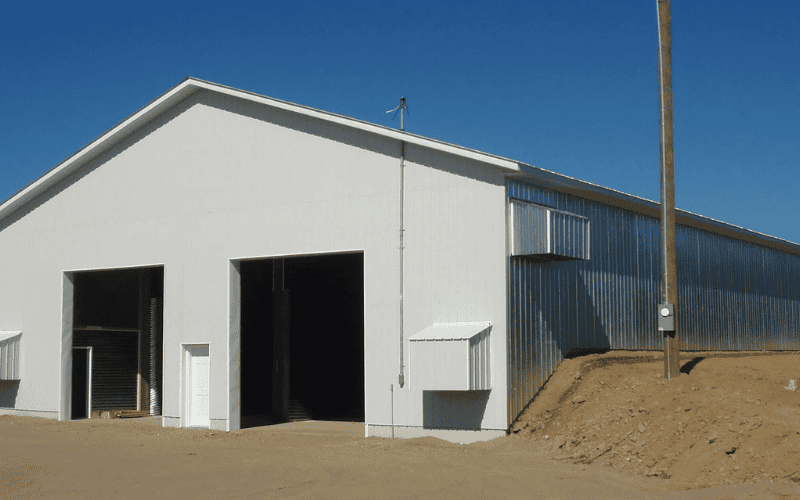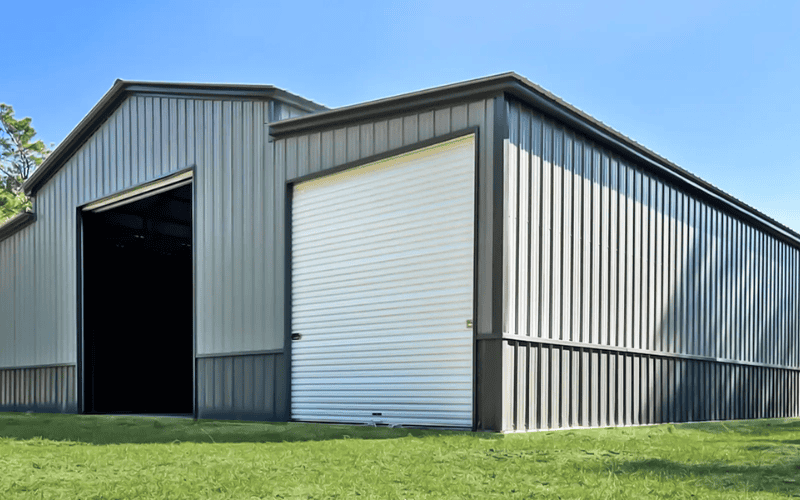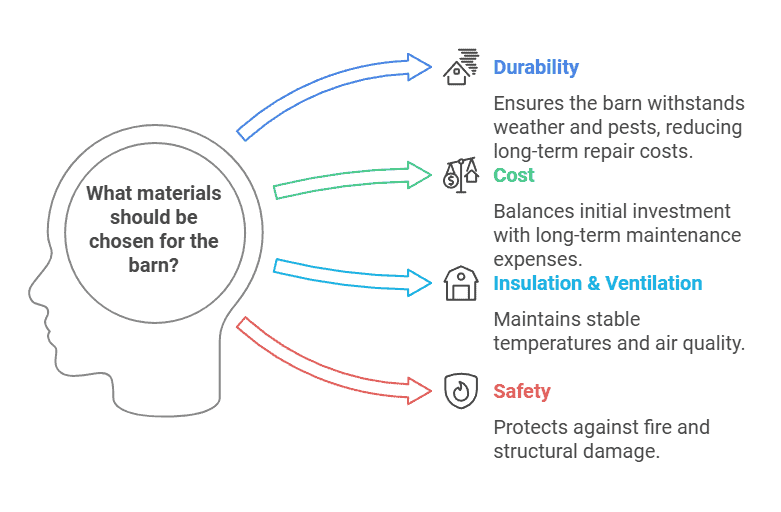Building a barn is a big deal—it’s not just about putting up four walls and a roof. Whether you’re planning to house livestock, store equipment, or create a space that does both, your barn needs to be functional, durable, and built to last. The first step? Figuring out exactly what kind of barn fits your needs.
Barns generally fall into two main categories: farmhouses, which often serve multiple purposes, and dedicated barns designed specifically for livestock housing or storage. But no matter the type, choosing the right building materials is key—factors like durability, cost, and insulation all come into play.
So, what’s the best material for building a barn? Let’s break it down and find the right fit for your project.
Choosing the Right Building Materials for Your Barn
Choosing the right barn material is key to durability, functionality, and cost. From timber’s charm to concrete’s efficiency and steel’s strength, each has its pros and cons.
Timber Framing
Timber framing, or post-and-beam construction, is a classic choice for barn building, known for its strength and rustic appeal. This method uses large wooden posts and beams as the framework, with joinery techniques like mortise-and-tenon to securely lock the pieces together. The process begins by setting vertical posts into the ground or onto a foundation, followed by attaching horizontal beams and diagonal braces for added stability. A timber-framed barn stands out with its exposed wood and natural grain, offering a warm, traditional look that’s both functional and visually timeless—an excellent option for those seeking a classic barn style.

Advantages:
- Natural Aesthetic: Timber framing offers a rustic and traditional look that many barn owners prefer, especially for farmhouses or barns in rural settings.
- Strength: Wood is durable and can handle heavy loads when used in the proper structural design.
- Sustainability: Wood is a renewable resource, making it an eco-friendly option if sourced responsibly.
Disadvantages:
- Maintenance: Wood can be susceptible to rot, termites, and pests, requiring regular maintenance to prevent deterioration.
- Fire Risk: Timber is highly flammable, which could be a safety concern depending on the location and intended use of the barn.
- Cost: Timber framing can be more expensive than some other materials, particularly high-quality wood or custom framing.
Insulated Concrete
Insulated concrete is a building material that combines concrete’s strength with built-in insulation, making it a great option for barns. It keeps interiors comfortable year-round by maintaining stable temperatures. This material is highly durable, fire-resistant, and soundproof, offering both safety and long-term performance. While it has a higher upfront cost and requires more time to construct, its energy efficiency and low maintenance make it a solid choice for barns, especially those housing livestock.

Advantages
- Thermal Insulation: Keeps barns cool in summer and warm in winter, ideal for housing livestock.
- Durability: Extremely strong, fire-resistant, and soundproof.
- Energy Efficiency: Regulates temperature well, making it more energy-efficient.
Disadvantages
- High Initial Cost: Costs much more upfront than wood or steel due to specialized materials and techniques.
- Complex Construction: Requires skilled labor and equipment, increasing time and expense. Pouring and curing must be precise.
- Limited Flexibility: Difficult to modify or expand, making it less adaptable for future needs.
- Foundation Requirements: Heavy material needs a reinforced foundation, adding to costs and labor.
- Environmental Impact: Concrete production has a high carbon footprint, unlike recyclable steel.
Related Reading: What Is the Difference Between a Pole Barn and a Metal Barn?
Steel Structure Frame
Steel structure framing is a practical and long-lasting option for barn construction, perfect for those prioritizing durability and low maintenance. Using steel beams and columns, this method creates a strong, rigid frame designed to withstand heavy loads and harsh weather. Pre-engineered components allow for quick and efficient assembly, reducing construction time. Steel barns are fire-resistant, pest-proof, and highly customizable, making them ideal for housing livestock, storing equipment, or other agricultural needs.

Advantages
- Strength and Durability: Steel structures are highly resistant to pests, rot, and fire, ensuring long-lasting durability for barns.
- Weather Resistance: Steel framing can endure harsh weather conditions, including heavy snow, strong winds, and extreme temperatures.
- Quick Construction: Pre-engineered steel components make assembly efficient and reduce labor costs, allowing for faster project completion.
Disadvantages
- Initial Cost: Steel barns often have a higher upfront cost compared to timber structures.
However, steel structure manufacturers design barns to minimize material waste and reduce costs without compromising quality. Additionally, low maintenance requirements over time make steel barns a cost-effective long-term solution.
- Insulation: Steel has lower natural insulation than wood or concrete.
To address this, we recommend using high-performance insulation materials like spray foam or insulated panels, which ensure energy efficiency and optimal temperature control for livestock and storage.
- Noise Levels: Steel barns can amplify sounds during heavy rain or hail, which might disturb livestock.
We suggest adding soundproofing materials or insulated panels to reduce noise and create a more comfortable environment for animals. These upgrades can be integrated into our prefabricated designs for easy customization.
For a barn that combines durability, low maintenance, and customization options, steel structure framing stands out as the best choice, offering unmatched value for both storage and livestock needs.
Additional Barn Building Materials
Choosing quality roofing, doors, and windows enhances your barn’s durability, comfort, and style.
Best Barn Roofing Materials
- Metal Roof Panels: Galvanized steel or color-coated panels are durable and weather-resistant, handling rain, wind, and snow with ease. Protective coatings prevent rust, giving a lifespan of 30-50 years. Prefabricated panels install quickly and efficiently, with wave or trapezoid shapes improving drainage and optional thermal coatings regulating temperature.
Best Barn Doors and Windows
- Metal Doors and Windows: Steel and aluminum options are strong, rust-resistant, and durable, standing up to livestock and equipment. Paired with sealing strips, they block wind and moisture while adding fire resistance and security.
- PVC Doors and Windows: Built with steel cores and PVC, they insulate well and are cost-effective. Customizable in style and color, they’re perfect for balancing function and design.
Steel-based materials for barns are recommended over wood and brick due to their superior durability, low maintenance, and resistance to weather, pests, and fire. These qualities make them a reliable, long-lasting choice for essential barn components.
With these advantages, it’s no surprise that barns are being used for more than just agriculture. In fact, many people explore the idea of converting barns into living spaces. Is it possible to live in a barn? Let’s take a closer look at what it takes to turn a barn into a comfortable home.
Key Considerations When Choosing Materials for Your Barn
The materials you choose for your barn directly impact its durability, safety, and adaptability—make decisions that save time, money, and effort.

Durability
Your barn’s materials must withstand constant exposure to weather and daily use. Metal and concrete structures excel in resisting rot, pests, and fire, making them great for long-term durability. Wood, while charming, needs regular maintenance to prevent decay. Opting for materials that hold up well over time reduces repair costs and keeps your barn functional for years.
Cost
Balancing upfront costs with long-term value is key. While some materials like timber are cheaper to start with, they might lead to higher maintenance expenses later. Durable materials like steel or concrete may cost more initially, but their low upkeep can save money in the long run. Always consider both the immediate and lifetime costs when budgeting.
Insulation and Ventilation
A well-insulated barn keeps temperatures stable year-round, which is critical for livestock and stored goods. Materials like insulated panels or foam boards can improve energy efficiency in any structure. Ventilation is equally vital to reduce moisture and maintain air quality. Features like vents, fans, or open eaves ensure your barn stays comfortable and functional.
Safety
Safety comes first, especially when housing animals or flammable materials like hay. Materials that are fire-resistant or pest-proof, like metal or treated wood, are great choices. Also, consider structural integrity—your barn should withstand strong winds, snow loads, or other natural forces without compromising safety.
Ease of Construction
Some materials are easier to build with than others. Prefabricated components, like metal panels, are quick to assemble, saving time and labor. In contrast, traditional masonry or timber framing requires skilled labor and more time. If you’re on a tight timeline, opt for materials designed for fast and efficient construction.
Flexibility
A barn should adapt to changing needs. Materials like metal allow for easy expansions or interior modifications, giving you the freedom to update your barn over time. Rigid materials like concrete are harder to modify once built. If future adaptability is important, choose materials that support flexibility.
Selecting the right materials ensures your barn remains durable, cost-efficient, and suited to your unique needs. Think ahead, and invest in materials that offer long-term benefits!
Choose Us For Your Barn Building
When it comes to building the perfect barn, the right material makes all the difference. Timber framing offers a classic, rustic charm but requires ongoing maintenance. Insulated concrete provides unmatched durability and temperature control but comes with higher costs and less flexibility. Steel structures, on the other hand, strike the best balance—they’re durable, low-maintenance, fire-resistant, and easily customizable, making them a smart long-term investment.
If you’re looking for strength, efficiency, and adaptability, a prefabricated metal barn is the way to go. It’s designed to handle the elements, requires minimal upkeep, and can be customized to fit your exact needs—whether for livestock housing, equipment storage, or multi-purpose use.
At SteelPRO PEB, we specialize in building metal structure barn that combine strength, durability, and practicality. Whether you need a warehouse barn or an animal-specific barn, our customizable metal structures are designed to meet your unique requirements. With quick assembly and long-lasting quality, our barns are built to serve you for years to come. Let’s build your perfect barn together!

